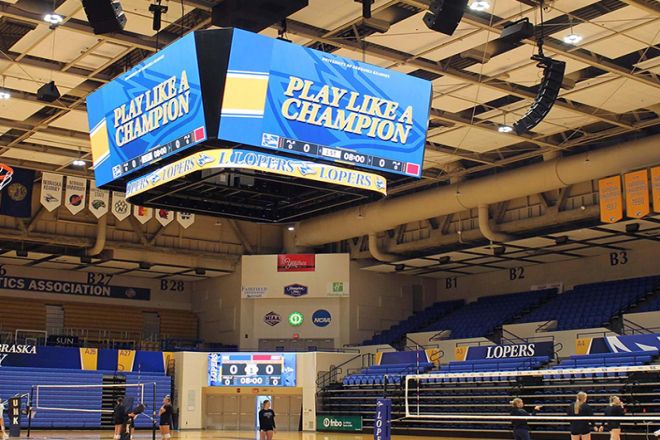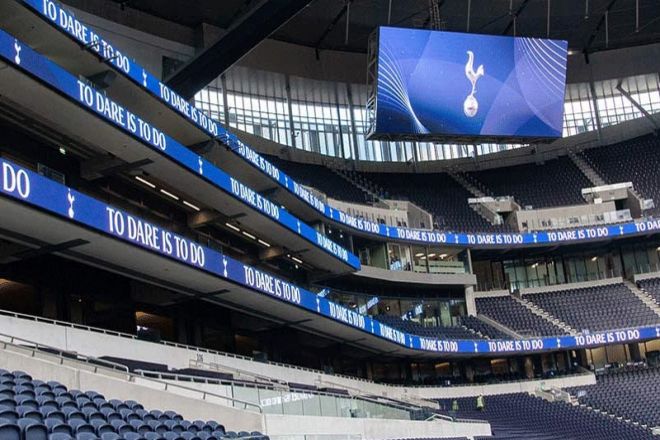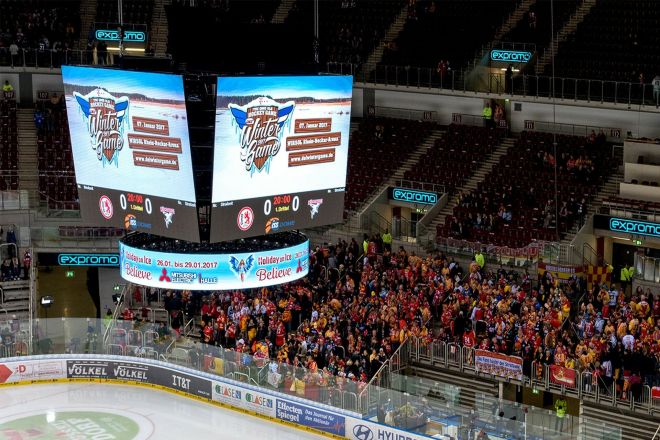介绍
1、体育场馆LED显示屏基本功能要求
- 高清画质与色彩还原
在现代体育比赛中,高清画质是LED显示屏不可缺少的基本功能之一。
高清分辨率不仅能够精准捕捉到比赛中的每一个细微动作,例如球员的面部表情、球的飞行轨迹等,还能给观众呈现更加细腻逼真的画面效果,大大增强了观众的沉浸感和参与感。
这种高度的视觉清晰度,使观众仿佛置身于比赛现场,与运动员同呼吸、同命运,大大增强了观赛的乐趣和吸引力。
此外,色彩精准度和动态范围也是营造现场氛围的重要因素,LED显示屏通过精准的色彩还原技术,能够呈现出更加丰富饱满的色彩层次,让画面更加生动活泼。
同时,宽动态范围可以保证暗部细节和亮部高光之间的良好平衡,避免画面过曝或欠曝,从而营造出更加真实震撼的视觉效果。这种色彩与光影的完美结合,不仅让观众感受到比赛的激烈与紧张,也激发了观众对体育运动的热爱与激情。
- 宽视角、亮度调节
在体育场馆中,观众座位往往分布较广,因此LED显示屏需要具备广视角技术,保证各个角度的观众都能得到清晰的观看体验。
广视角技术可以降低不同观看角度下画面的扭曲变形,使观众无论坐在哪里都能享受到最佳的视觉效果。该技术的应用不仅提高了观众的满意度和舒适度,也提升了场馆整体的观影氛围。
同时,亮度调节也是体育场馆LED显示屏不可缺少的功能,由于体育比赛可能在室外或室内举行,光照条件各不相同,因此LED显示屏需要根据实际环境光自动调节亮度。
在室外强光下,显示屏需要提高亮度才能保证画面清晰可见,而在室内较暗的环境下,则需要适当降低亮度,避免对观众造成眩光。此智能亮度调节功能不仅保护了观众的视力健康,还提高了显示屏的节能效果和使用寿命。
- 响应速度快,延迟低
在高速的体育赛事中,LED显示屏的快速响应能力和低延迟特性至关重要。快速的响应能力保证显示屏在接收到信号后快速更新画面内容,减少画面拖影、残影的发生。
这对于捕捉运动员的快速动作和瞬间变化至关重要,确保观众不会错过任何精彩瞬间。
同时,低延迟技术也是保证直播、即时回放等应用顺利进行的关键,在直播过程中,低延迟可以保证画面与现场情况同步呈现,减少观众感受到的时差和滞后。
在即时回放环节,低延迟可以保证回放画面与原画高度一致,让观众清晰看到比赛中的每一个细节和关键时刻。这种实时流畅的回放效果不仅提升了观众的观赛体验,也增强了比赛的观赏性和公平性。
2、体育场馆LED显示屏的高级应用要求

- 互动性和定制内容
随着科技的进步,观众对于体育赛事的参与度要求越来越高,LED显示屏则展现出了巨大的互动潜力。通过融合先进的互动技术,LED显示屏可以实现观众与赛事的实时互动,如实时投票、弹幕评论等功能。
这些功能不仅增强了观众的参与感和归属感,也让比赛氛围更加热烈有趣。观众可以通过手机或其他智能设备发送投票或评论,这些内容会即时显示在LED显示屏上并与观众分享,形成全新的观赛体验。
此外,定制化内容显示也是LED显示屏在体育场馆的重要应用之一,赞助商可以与场馆合作,将定制化的品牌内容,如广告、宣传视频等,在LED显示屏上显示。
这种定制内容不仅能满足赞助商的品牌宣传需求,增加品牌曝光度,还能为场馆带来额外的收入来源。同时,定制内容还可以根据比赛的进展、观众的心情等进行灵活调整,以达到最佳的宣传效果。
- 大数据分析与智能推荐
在体育场馆中,LED显示屏与大数据技术的结合,为观众提供了更加个性化的观赛体验,通过采集和分析观众的观赛数据、行为偏好等信息,场馆可以构建观众的个性化画像,为观众提供个性化的赛事信息推荐。
例如,在比赛开始前,LED显示屏可以根据观众的喜好推荐相关赛事介绍、选手信息等内容;比赛过程中,可以实时推送比赛精彩片段、精彩回放等观众可能感兴趣的信息。
这套智能推荐系统不仅提高了观众的观赛满意度,也提升了场馆的服务质量和竞争力。
同时,大数据技术在优化广告投放、提升场馆运营效率方面也发挥着重要作用,通过对受众数据的深入分析,场馆可以更精准锁定目标受众,优化广告策略,提高广告转化率。
此外,大数据技术还可以帮助场馆实现智能化管理,如人员的智能调度、设备状态的智能监控等,从而提高场馆的运营效率和安全性。
- 多场景切换及集成控制
运动场馆经常需要承接各种类型的活动,比如演唱会、展览会等,因此LED显示屏需要具备快速切换显示内容的能力,以满足不同活动的需求。
LED显示屏通过融合先进的控制系统和技术手段,可以在短时间内完成从体育赛事到演唱会、展览会等不同场景的切换,这种多场景切换能力不仅提高了场馆的利用率和灵活性,也满足了观众对多元化娱乐体验的需求。
此外,集成控制系统在多块LED屏、灯光、音响等设备的统一管理上也显示出了巨大的优势,通过集成控制系统,场馆可以实现多台设备的集中控制和协调管理,保证各设备之间的无缝连接和协同工作。
这种一体化的管理方式不仅提高了场馆的运营效率和管理水平,减少了人力成本和运维难度,同时,集成控制系统还可以根据活动的具体需求进行灵活的配置和调整,满足不同活动的特殊需求。
3. 技术挑战与解决方案
1). 成本控制与成本效益优化
虽然LED显示屏在体育场馆的应用带来了显著的视觉效果和观众体验的提升,但其高昂的前期投入成本也成为不容忽视的技术挑战。对于体育场馆而言,巨额的投入不仅增加了财务负担,还可能影响场馆的日常运营和盈利能力。
为了降低成本,提高性价比,可以从以下几个方面入手:
- 技术创新:
通过不断的技术研发与创新,提高LED显示屏的生产效率和性能,从而降低生产成本。例如,采用更先进的制造工艺和材料,提高发光效率和稳定性,降低能耗和维护成本。
- 规模生产:
随着LED显示屏市场的不断扩大,通过规模化生产可以进一步降低单位产品成本,体育场馆可以与供应商建立长期合作关系,批量采购LED显示屏,享受更优惠的价格和服务。
- 定制设计:
在满足基本需求的前提下,根据体育场馆的实际情况和预算约束进行定制化设计,避免不必要的浪费和功能冗余。定制化设计可以保证LED显示屏与场馆整体风格、氛围协调的同时,实现有效的成本控制。
2).维护升级方便
LED显示屏在长期运行过程中需要定期进行维护与保养,以保证其正常运行,延长使用寿命,但传统的维护与升级方式往往存在效率低、成本高等问题。
为了解决这些问题,可以采用如下技术手段:
- 模块化设计:
LED显示屏设计成多个独立的模块单元,每个模块单元都可以单独进行维护和更换,这样的设计可以大大简化维护流程,降低维护成本,提高维护效率。
- 远程监控:
采用远程监控技术,可以实时监控LED显示屏的运行状态,及时发现和处理潜在问题。远程监控可以减少现场巡检次数和人力成本,同时提高响应速度和解决问题的能力。
- 智能管理:
通过智能管理系统对LED显示屏进行集中管理控制,实现远程开关机、亮度调节、内容更新等功能,智能化管理可以提高场馆的运营效率和管理水平,减少人工成本和维护难度。
3).环境保护与可持续发展
随着环保意识的不断提升,体育场馆在建设和运营过程中也越来越注重环保和可持续发展,而作为重要的视觉显示设备,LED显示屏的环保性能也备受关注。
为了促进环境保护和可持续发展,可采取以下措施:
- 绿色材料:
使用环保材料生产LED显示屏,减少对环境的影响。例如,使用可回收材料制作显示屏外壳、电路板和其他部件。
- 低功耗技术:
采用低功耗LED芯片及驱动电路,减少能耗及碳排放,同时智能调光技术可根据环境光自动调节亮度,进一步降低能耗。
- 回收和废物处理:
建立完善的废弃物处理机制,对废弃的LED屏幕及其部件进行分类、回收、再利用,同时鼓励供应商、制造商参与回收计划,共同推动环境保护的发展。
4. 未来展望

1).体育场馆LED显示技术的发展趋势
随着科技的不断进步,体育场馆LED显示技术将呈现更加多元化、智能化的发展趋势,以下是对LED显示技术未来发展的一些预测:
- 更高清晰度:
随着显示技术的不断突破,LED显示屏的分辨率将进一步提高,为观众带来更加细腻逼真的视觉效果。高清晰度将使比赛画面更加清晰,运动员的动作、表情每一个细节都能被观众捕捉到。
- 更智能的交互体验:
未来的LED显示屏将不仅仅是一个显示工具,更是一个智能互动平台,观众可以通过手机或其他智能设备与LED显示屏进行互动,参与游戏投票、发表评论、观看个性化内容等,大大提升了观看体验。
- 更广泛的应用场景:
除了传统的体育赛事,LED显示屏还将被广泛应用于体育场馆的各个角落,包括观众席、休息区、商业区等,通过不同的应用场景和显示内容,为观众提供更加丰富多彩的观赛体验。
2).新兴技术对LED显示屏应用的潜在影响
新兴技术的快速发展将对LED显示屏在体育场馆的应用产生深远的影响。以下是一些主要的新兴技术及其潜在影响:
- AR/VR技术:
增强现实(AR)与虚拟现实(VR)技术的结合,将为LED显示屏带来新的应用场景和展示方式,观众可以通过佩戴AR/VR设备在虚拟环境中观看比赛,享受更加身临其境的观赛体验。
同时,AR/VR技术还可以为LED显示屏提供更加丰富、动态的显示内容,如虚拟广告、虚拟观众等。
- 5G通信技术:
5G通讯技术的普及将大大提高数据传输速度和稳定性,为LED显示屏的实时更新、互动提供有力的支持。
观众可通过5G网络实时观看比赛直播、参与互动活动等,享受更加流畅、便捷的观赛体验。
3)技术创新与提升观众体验同等重要
在未来体育场馆的发展中,技术创新与提升观众体验同等重要,技术创新是LED显示技术不断进步的重要驱动力,而观众体验则是衡量技术成功的关键标准。
因此,在体育场馆建设和运营中,应始终把技术创新、观众体验放在第一位,不断推动LED显示技术的创新与应用,为观众提供更好、更便捷的观赛体验。
具体来说,可以从以下几个方面入手:
加大研发投入,推动LED显示技术不断创新升级;
关注观众需求,不断优化LED显示屏的显示内容和形式;
加强新兴技术的融合应用,探索LED显示屏在体育场馆新的应用场景和显示方式;
加强人才培养和队伍建设,为LED显示技术创新和应用提供有力保障。
结论
综上所述,体育场馆对于LED显示屏的需求是多层次、多维度的,它既是科技进步的产物,更是观众体验升级的必然要求。
随着技术的不断进步和应用的不断深入,LED显示屏将在体育赛事中发挥越来越重要的作用,为观众带来更震撼、更智能、更个性化的观赛体验。
最后,如果您想了解更多关于LED显示屏的知识, 请与我们联系。

